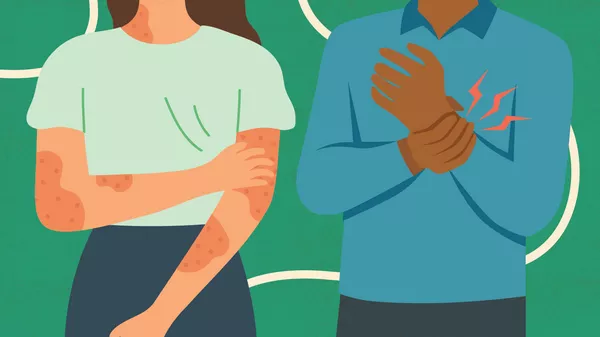Psoriatic arthritis (PsA) is a chronic inflammatory condition that affects both the skin and joints. It is a type of arthritis that often occurs in people with psoriasis, a skin disease characterized by red, scaly patches. The pain associated with psoriatic arthritis can be debilitating, significantly impacting the quality of life of those affected. This article explores the reasons why psoriatic arthritis hurts so badly, examining the underlying mechanisms, symptoms, and potential treatment options.
Understanding Psoriatic Arthritis
What is Psoriatic Arthritis?
Psoriatic arthritis is an autoimmune disease, which means the body’s immune system mistakenly attacks its own tissues. In PsA, the immune system targets the joints and skin, leading to inflammation, pain, and damage. This condition can affect any joint in the body and can vary in severity from mild to severe.
Symptoms of Psoriatic Arthritis
The symptoms of psoriatic arthritis can vary widely among individuals but commonly include:
- Joint pain and stiffness
- Swelling and tenderness in the joints
- Reduced range of motion
- Fatigue
- Dactylitis (swelling of an entire finger or toe)
Enthesitis (inflammation where tendons or ligaments attach to bone)
Skin rashes and nail changes (similar to those seen in psoriasis)
Why Does Psoriatic Arthritis Hurt So Much?
Inflammation and Joint Damage
The primary cause of pain in psoriatic arthritis is inflammation. Inflammation is the body’s natural response to injury or infection, but in autoimmune diseases like PsA, it becomes chronic and widespread. The inflammation in PsA affects the synovium, the lining of the joints, leading to swelling, redness, and pain. Over time, chronic inflammation can cause permanent joint damage and deformities, which contribute to persistent pain and discomfort.
Enthesitis and Dactylitis
Two unique features of psoriatic arthritis that contribute to its pain are enthesitis and dactylitis. Enthesitis is the inflammation of entheses, the sites where tendons or ligaments insert into the bone. This inflammation can cause severe pain and tenderness, especially in the heels, knees, and elbows. Dactylitis, also known as “sausage digits,” refers to the swelling of entire fingers or toes. This swelling is painful and can make it difficult to use the affected digits.
Skin and Nail Involvement
The skin and nail involvement in psoriatic arthritis can also contribute to pain. Psoriasis lesions can be itchy, painful, and prone to cracking or bleeding. Nail changes, such as pitting, discoloration, and separation from the nail bed, can be painful and interfere with daily activities.
Fatigue and Pain Amplification
Fatigue is a common symptom of psoriatic arthritis and can exacerbate the perception of pain. Chronic pain and inflammation can disrupt sleep, leading to fatigue and further increasing pain sensitivity. Additionally, the constant pain and fatigue can affect mental health, leading to depression and anxiety, which can amplify the perception of pain.
Mechanisms of Pain in Psoriatic Arthritis
Immune System Dysregulation
The immune system plays a central role in the development and progression of psoriatic arthritis. In PsA, the immune system becomes dysregulated, leading to the production of pro-inflammatory cytokines, such as tumor necrosis factor-alpha (TNF-alpha), interleukin-17 (IL-17), and interleukin-23 (IL-23). These cytokines promote inflammation and joint damage, contributing to pain.
Central Sensitization
Central sensitization is a phenomenon where the central nervous system becomes hypersensitive to pain signals. This can occur in chronic pain conditions like psoriatic arthritis. In central sensitization, the nervous system amplifies pain signals, leading to increased pain sensitivity and the perception of pain in response to normally non-painful stimuli.
Peripheral Nerve Involvement
Peripheral nerves, which transmit pain signals from the joints and skin to the brain, can also be affected in psoriatic arthritis. Inflammation and damage to these nerves can lead to neuropathic pain, a type of pain caused by nerve dysfunction. Neuropathic pain is often described as burning, tingling, or shooting pain and can be particularly difficult to manage.
SEE ALSO: The Best Drugstore Lotion for Psoriasis
Managing Pain in Psoriatic Arthritis
Medications
Several medications are available to help manage the pain and inflammation associated with psoriatic arthritis:
- Nonsteroidal Anti-Inflammatory Drugs (NSAIDs): These drugs can help reduce pain and inflammation but may not be sufficient for severe cases.
- Disease-Modifying Antirheumatic Drugs (DMARDs): DMARDs, such as methotrexate, can help slow the progression of the disease and reduce pain.
- Biologic Agents: Biologics, such as TNF inhibitors (e.g., adalimumab, etanercept) and IL-17 inhibitors (e.g., secukinumab), target specific components of the immune system to reduce inflammation and pain.
- Corticosteroids: These drugs can be used for short-term relief of severe inflammation and pain.
Physical Therapy
Physical therapy can be beneficial for managing pain and improving joint function in psoriatic arthritis. A physical therapist can design a tailored exercise program to help maintain joint flexibility, strength, and overall physical fitness. Techniques such as hot and cold therapy, ultrasound, and transcutaneous electrical nerve stimulation (TENS) may also be used to relieve pain.
Lifestyle Modifications
Certain lifestyle modifications can help manage pain and improve overall health in individuals with psoriatic arthritis:
- Regular Exercise: Low-impact exercises, such as swimming, walking, and cycling, can help maintain joint function and reduce pain.
- Healthy Diet: A balanced diet rich in anti-inflammatory foods, such as fruits, vegetables, and omega-3 fatty acids, can help reduce inflammation and improve overall health.
- Weight Management: Maintaining a healthy weight can reduce the strain on the joints and decrease pain.
- Stress Management: Techniques such as mindfulness, meditation, and yoga can help reduce stress and improve pain management.
Complementary Therapies
Complementary therapies, such as acupuncture, massage, and chiropractic care, may provide additional pain relief for some individuals with psoriatic arthritis. It is essential to discuss these therapies with a healthcare provider to ensure they are safe and appropriate.
Conclusion
Psoriatic arthritis is a complex and painful condition that affects both the skin and joints. The pain associated with PsA is primarily due to chronic inflammation, joint damage, and unique features such as enthesitis and dactylitis. Additionally, factors such as immune system dysregulation, central sensitization, and peripheral nerve involvement contribute to the severity of pain.
Effective management of psoriatic arthritis pain requires a multifaceted approach, including medications, physical therapy, lifestyle modifications, and complementary therapies. By addressing the underlying mechanisms of pain and inflammation, individuals with psoriatic arthritis can achieve better pain control and improve their quality of life. If you suspect you have psoriatic arthritis or are experiencing severe pain, it is crucial to seek medical advice and work with a healthcare provider to develop a comprehensive treatment plan tailored to your needs.
Related Topics:


























